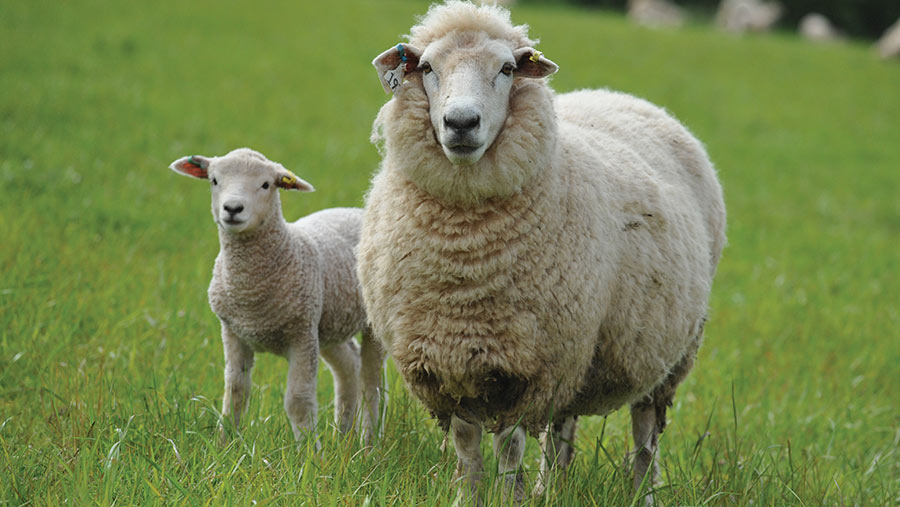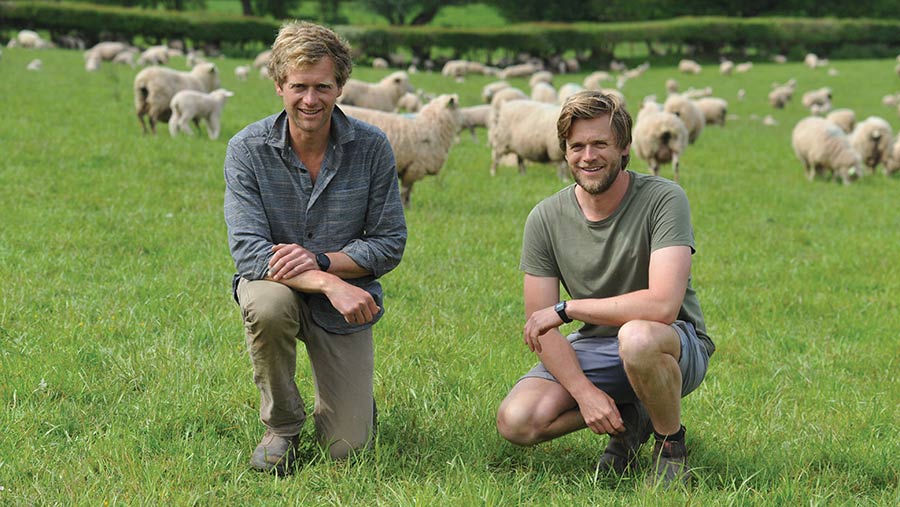8 ways sheep farmers can adopt regen methods
 A ewe and lamb from the Sawday's flock © Debbie James
A ewe and lamb from the Sawday's flock © Debbie James Coaxing more life out of the soil is a work in progress at Hill Farm, near Hay-on-Wye. Here, Sam and Will Sawday and their mother, Penny Chantler, run a flock of 1,400 pedigree New Zealand Romneys.
At 400m above sea level, grass growth does not kick in until the end of April.
But by building organic matter and soil biology through mob-grazing, and reducing herbicide, insecticide and wormer use, the business no longer relies on manufactured fertiliser to produce feed.
How grazing change can help soil health and resilience
Not every technique works on every farm, so the family have trialled various practices and settled on changes that are right for their farm and system.
“Regenerative farming was a natural progression from our low-cost, forage-only system,” Will explains. “Now, we have taken it to the next level.”
Here, Will offers some guidance to farmers considering a move to regenerative farming.
Farm facts: Hill Farm, Hay-on-Wye
- 600 recorded stud Romneys and RomTex ewes; 800 commercial Romneys
- Lambs sold as breeding stock, fat lambs and stores
- Sales July-January
- Fat lambs supplied to Farmers Fresh at 18.5kg deadweight
- Store lambs sold at Hereford livestock market
- 120 shearling rams sold annually
- Private sales of breeding stock
- 2023 scanning average of 180% in stud flock; 150% in commercial flock

Will and Sam Sawday © Debbie James
1. Connect with like-minded farmers
We have a strong community of farmers in this area who are all thinking along the same lines.
Five years ago, about 12 of us got together as a discussion group to share ideas and advice.
That support network has been really important because it can sometimes feel like a leap of faith to remove an input or make a change to grassland management.
In the group, there is often someone who is further ahead who can give advice and guidance.
2. Not every benefit is clearly measurable
Our business needs to be financially robust, so the regenerative practices we are adopting must satisfy that goal – and our social and environmental ambitions.
We are keen on monitoring, but the benefits we see are a lot less clear cut than simply producing more lamb from an acre of land or at a higher weight.
Having more wildlife on the farm indicates a healthy system, and that means healthy plants and healthy livestock with fewer inputs and treatments to get the same performance.
3. Consider use of fulvic acid with glyphosate
Glyphosate is the only chemical now applied on the farm and we have halved the quantity used by mixing it with fulvic acid.
This improves its effectiveness at low rates and buffers against some of the damaging impacts to soil microbiology.
After applying the mix, we spread imported chicken muck, then direct-drill brassica mixes, mostly swedes, turnips and kale, but also cover crops with clover, Italian ryegrass and chicory.
Pregnant ewes graze 20ha (50 acres) from around Christmas to the end of February.
Once they have finished, we have a pre-lambing graze of the tupping fields, before set stocking for outdoor lambing in April.
4. Mob-grazing looks different for every system
We run the flock in three equal mobs. The size of the paddocks varies, but we try to make sure the sheep are not in the same one for longer than four days, to prevent re-grazing.
It can be 12 hours or four days but is typically short bursts of high-impact grazing to encourage regeneration.
We used to have short rest periods of about 25 days, and in the past few years have been trialling grazing one-third, trampling one-third and leaving one-third.
We are now at a point where we have a hybrid of the two.
Lactating ewes and lambs up to a year old will graze shorter covers, grazing 10cm down to 4cm, for quality.
Weaned ewes graze tall covers where applicable, as quality is not so much of an issue for this class of sheep.
This method increases rooting depth, which increases environmental resilience and allows plants to access more nutrients from deeper in the soil.
The longer rest periods will help to break the intestinal worm cycle, reducing the amount of drenching we do.
5. Keep refining the system
For us, it is about getting the stocking rate and pasture utilisation right to gives us a better return on our fixed costs and improve pasture quality.
With 1,400 sheep on 243ha (600 acres), our stocking rate is low, however, we very rarely feed concentrates or buy forage.
This summer, for the first time, we will have cattle – 90 steers, weighing around 400kg, grazing some of the land in an agreement with another farm, to build soil fertility and break the worm cycle.
We will also increase ewe numbers to 1,500 in the autumn. These stocking rates are achievable without compromising soil health or pasture quality and will give us a better payback on our fixed costs.
Although we have minimal infrastructure, there are certain costs that we can’t get away from, like rent, mortgage payments, fuel and contractors.
6. Unlock the hidden value in soil
Detailed soil tests have shown we have heaps of phosphorus and potassium, but in a form that is not available to plants. As we improve our soil biology, plants will be able to access those nutrients.
Compaction was a limiting factor, and we also have high levels of magnesium, which makes the soil wet and clammy, so we have applied gypsum and lime to aerate it and make it more friable.
We have also subsoiled with a “rip-and-drip” method. This involved a subsoiler with an attached tank filled with a mix of fish hydrolysate, molasses and liquid gypsum.
This liquid runs down the back of the machine legs during subsoiling to feed the fungi and bacteria and kick-start them into action.
7. Breed for parasite resistance to reduce treatments
As a sheep-only system, parasitic worms are our biggest limiting factor, but we have been breeding for resistance for 20 years as a part of our ram breeding programme.
Our protocol is to select a cross-section of 120 ram lambs and expose them to a worm challenge, allowing the count to rise to 800 eggs per gram (epg).
Animals are weighed, before and after, to track growth, and individual worm egg counts are taken to assess burden levels.
We feed these data into our estimated breeding values (EBVs) to produce worm-resistance breeding values.
Animals that have grown well enough through the challenge and have a low faecal egg count are kept or sold to customers.
Those that lose weight are susceptible and are not retained. All sheep that get fly strike are culled as our aim is to eliminate all fly sprays.
8. Breed sheep to fit the system
Breeding sheep with excellent foraging ability, vigour and disease resistance is the most effective way for our farm to transition, with smaller, hardier sheep that can tolerate fluctuating weather conditions and feed type and quality.
The measure for success has got to be more than just surviving, though, it has to be yield. If a ewe can yield well in a low-cost system like this, then happy days.
